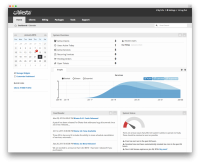Leaderboard
Popular Content
Showing content with the highest reputation on 01/25/2016 in Posts
-
Blesta has a template system. It follows the MVC design pattern where the views (templates) are constructed dynamically from the needs of the controller and injected into the page structure where necessary. This is common practice now to save processing resources over less efficient designs and to separate business logic from presentation. If you find the design confusing, as you've mentioned at least three times, that's usually a good point to stop and take a step back to analyze what you're doing and to understand the constraints of the design you're working within. The template (.pdt) files for the admin and client UIs are found under /app/views/admin/ and /app/views/client/ respectively. Most template files are named according to the controller and method from which they extend for the page that they render. This naming scheme can also be derived from the URI of most pages in your browser, e.g. a URI of '/admin/clients/' is constructed from the /app/views/admin/default/admin_clients.pdt template file. I'm not sure what you're intending to do. After reading this thread, I don't think you've adequately described the behavior you're expecting to accomplish. "Wrapping" Blesta code means you are nesting it within your own. Blesta generates complete HTML pages, so unless you're using an iFrame or using the Blesta API to display your own content, "wrapping" it is not something that would work for you. Blesta does not contain all HTML in one file. This is why we have templates. You could change the parent template (structure.pdt) which generates the header and footer of every page, but that depends on the results you intend to achieve. Per the MVC design and the separation of business logic, templates do not make calls to anything in code. Curious which template calls you are referring to. As I mentioned above, when confused, step back and take a look at the bigger picture. Blesta is designed to be developer-friendly, where the source code is available for edit, natively. I get the feeling that you are not a developer per se, but rather an end-user programmer. It's common for end-user programmers to shy away from better designs, if only because they appear complex and unfamiliar. However, the MVC design is far superior to many other designs, which is why it has become popular in web application development. The mods/plugins others have mentioned are extensions to Blesta, like the Portal plugin, to enhance functionality beyond the core system. The Portal plugin currently only allows the edit of the main homepage of your Blesta installation. Anything else that is more custom needs to be written as such. naja7host's Admin Tools plugin, for instance, allows you to define more custom pages beyond simply the homepage of your Blesta installation like the Portal plugin allows. You say the competitor's script is easier to work with because they have a proper system? To which proper system are you referring? Contrary to your interpretation, your screenshot comparison of a template shows me that Blesta is easier to work with from a developer's stand-point. Here's a few reasons why: Blesta provides access to source code in templates, that is, the source PHP that renders template HTML, giving you complete control over its use Blesta does not obfuscate code through a middle-ware system, like Smarty templates, which adds additional syntax to understand and an unnecessary second layer to UI presentation Blesta makes it easy to secure your display of variables by using the HTML helper. Using the helper keeps you from making common mistakes that lead to XSS vulnerabilities by forcing variables to be output HTML-safe Blesta makes it easy to generate forms using the Form helper. The Form helper also embeds a CSRF token to prevent users from being the victim of CSRF attacks in Blesta. Blesta appears to be tabbed better for read-ability Blesta defines a more modern structure of HTML and CSS to avoid out-dated uses of multiple line breaks (e.g. <br /><br />) where paragraphs or CSS padding/margin should be used instead. Additionally, inline attributes (e.g. "align=") like "<p align='center'>" are avoided in lieu of proper CSS styling defined in stylesheets. I'm not sure why you think the second screenshot looks more appealing, but looks are subjective. I work within objective constraints. tl;dr What are you looking to accomplish with your theming exactly? It may be better for us to understand what you're doing if you could describe what parts of the system you intend to change, in what way, and provide examples to illustrate these points.1 point
-
ACH support is something that could be added to the gateway with Blesta.1 point
-
I'm unclear on exactly what your intentions are--to either create an addon service (a separate service altogether) or add fields to the Universal Module service. Both are very different. From your screenshot, I can see you attempted to perform the latter. The reason only the names of the service options appear is because you have not defined any service option values (i.e. the radio options). Take a look at the documentation. I think you want to only have one service option line rather than two. Set the label and name field to whatever you like, the type to 'radio', and the values field to: "option1:Option 1|option2:Option 2".1 point
-
Settings > Company > Billing/Payment > Invoice Customization. Add it to "Terms".1 point
-
1 point



